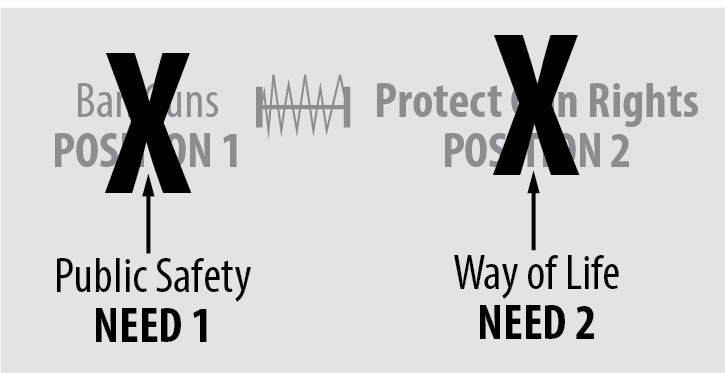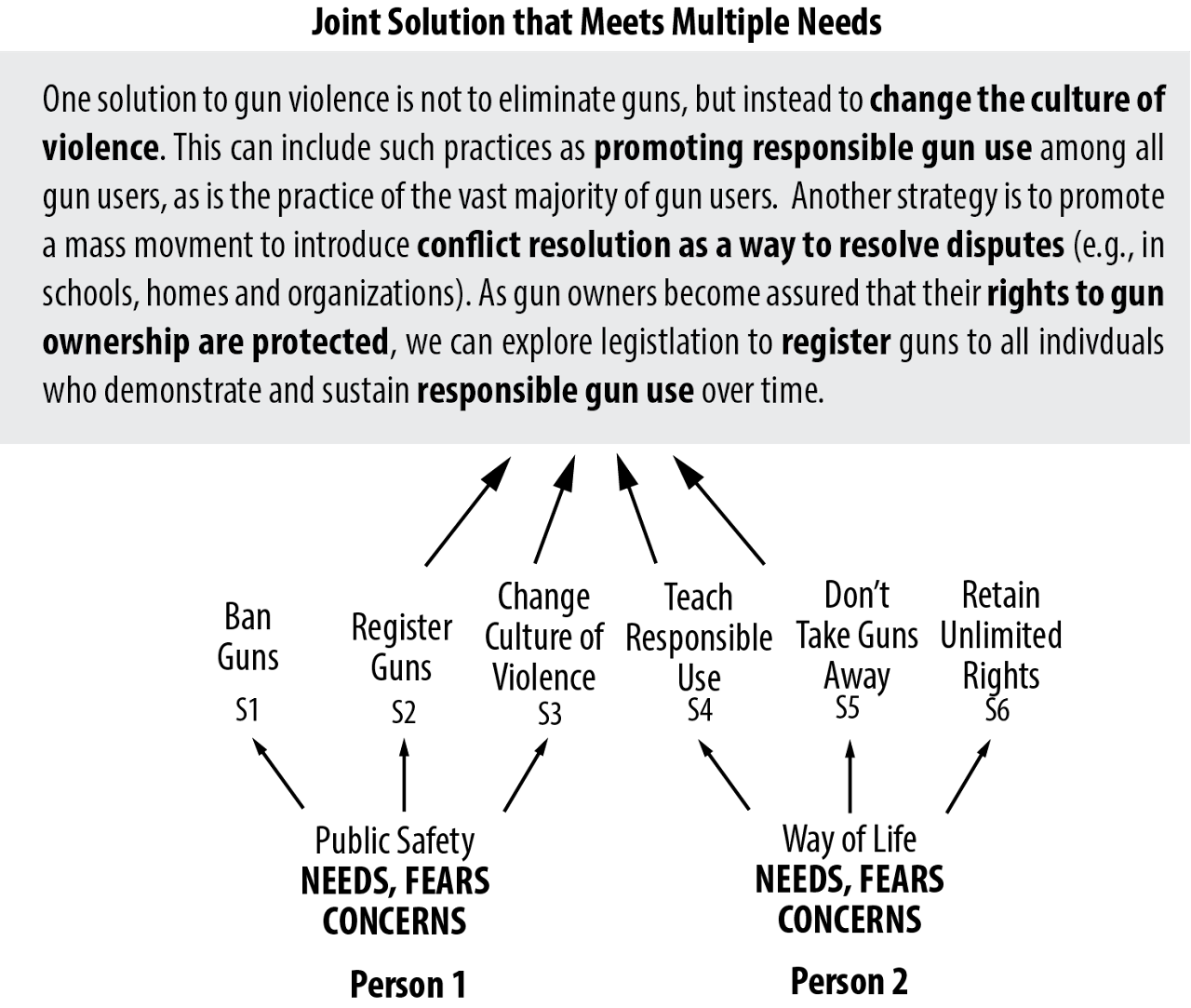Bridging political divides involves the same skills that we need when we are trying to resolve everyday conflicts. When parties focus on meeting each other's needs rather than on asserting their political positions, problems begin to solve themselves.
Political arguments get heated when people begin to blame and characterize other people and their positions. Here's how to avoid this problem.
They say we shouldn't collaborate with the enemy. But the alternative to collaborating with one's opponent is war.
Here is an example of how Collaborative Problem-Solving can work to bridge divides on the contentious political issue of how to deal with gun violence.
Staying calm is key. Here is how to do it.
Bridging Political Divides

Political discussions usually take the form of a debate. We advance our position, the other person offers a counter-point. We attack. Our opponent defends. We continue by trying to show the other person that we are right and they are wrong. Or perhaps, we are trying to convince those who are watching us debate.
But the problem, of course, is that we rarely convince each other about sensitive topics through confrontation. Instead, we simply push away the very people we hope to influence.
We know this from our everyday life. Let’s take a look at how this happens.
Political Talk Gone Wrong
Here is an example of how our contemporary approach to political discussions fails. In this exchange, Larry, Greg and Aron are discussing hate crimes in an online forum.
GREG: Don’t be so sure that the FBI will continue to be as diligent [pursuing hate crimes] under the Jeff Sessions DOJ as they have been for the last 8 years. People should report to their local police, the FBI, and civil rights groups in hopes at least one of them will respond.
LARRY: Diligent? They don’t go after left-wing radicals. Besides, many or most of the so-called hate crimes are being committed against Jews and people trying to stand up against the hatred coming from the left, BLM, Farrakhan devotees, and thugs rioting in the streets burning down their own neighborhoods.
Larry responds not by seeking to address the problems raised by Greg, but by attacking Greg’s position. Larry engages in three practices that cause the discussion to degenerate quickly. He invokes “us versus them” thinking; diminishes the importance of Greg’s concerns; and blames hateful violence on groups described using language that many would regard as racist. Taking offense, Aron attacks back:
ARON: Uhm, those hate crimes against Jews are coming from Trump supporters like yourself…You are ADORABLY ignorant.
And so, the discussion quickly degenerates into name calling. No one has changed their views. If anything, the parties are more entrenched than they were when they began.
Engaging the Humanity of the Other — Even When the Other Isn’t Very Engaging
We cannot eliminate hate by force. If we want to oppose hate, we have to do it by tending to the internal and external conditions that foster hate. This can only be done by forging relationships with those with whom we disagree.
This isn’t easy. To do this, we must look beneath what a person says to uncover the fears, needs, and beliefs – however reasonable or unreasonable — that motivate people to adopt their positions. We need to separate the other’s position from the person herself. When we engage the needs behind the position, we can begin to explore why the other thinks and feels as they do.
Something like this occurred in when Greg asked Larry an open-ended question about how to bridge the gap between them:
GREG: You and I look like a perfect example of Americans who seem to live in different universes, Larry. I wish has had some idea what to do about it. Do you? (Either one of just telling the other just to get out of their bubble is probably useless.)
Greg’s compassionate question opens up space for Larry to respond. If we seek to understand rather than simply condemn, we can learn much about Larry’s thinking and feeling.
LARRY: [If] you’re speaking…about the world the left lives in, then I think there is nothing that can be done about it. Those under 50 have no idea what socialism or communism is so they will not change their beliefs until they live under the forms of government they champion. I, for one, fought against communism and socialism while serving in VN in the 60s and I assure you they are butchers, they are criminals, they are Godless, and they are cruel….Muslims as well suffer under the Islamist Nazis running rampant in the world today. My world is one of traditional values where good is good, evil is evil, we want the government to leave us the he!! alone and people fight for freedoms, not the right to force their beliefs onto others…
If we put aside our own biases long enough, we learn that Larry believes in freedom. As a product of his experiences in Viet Nam, he believes that socialism, communism and forms of totalitarianism breed cruelty. Larry embraces traditional values in which good and evil are not relative values. If we listen closely, we may find that we can appreciate some of what Larry has to say. But we need not agree with Larry’s views to understand them and appreciate how he could embrace them. He is not an alien.
We Must Talk — Even Collaborate — with Our Enemies
Once we begin to see our opponent as human being with human needs, real problem solving can begin. We can begin to look for ways to mitigate the fears and concerns that incite views we regard as hateful, racist, bigoted, and so forth. For example, Greg and Aron might be able to introduce Larry to minorities, leftists, and persons from diverse cultures and religions whose ways of being in the world disconfirm Larry’s expectations. Conversely, drawing upon his wartime experiences, Larry might be able to remind his interlocutors of the privileges they enjoy as citizens of a democratic nation.
We must always act forcefully to protect those who are harmed by bigotry and hate. However, we cannot eliminate hate through force or violence. We must talk to our enemies and seek to understand the pleas behind their positions. It does not diminish me to understand and even empathize with persons with whom I disagree – it actually increases the likelihood that we will be able to create some sort of common ground. I am diminished, however, when I reject the other without trying to make contact with their humanity– even when it appears that they are unable or unwilling to do the same.
The basic process of bridging divides involves arises from applying principles and practices of conflict resolution to political disputes. Political disputes tend to involve people who adopt different positions on a given political issue.
For example, for issues related to gun violence, gun regulation and gun owners tend to adopt conflicting positions:

Gun control advocates seek to limit access to guns in some way, while gun rights activists seek to preserve legislative rules that ensures the right to gun ownership (e.g., the second Amendment to the U.S. Constitution). The first step to collaborate problem-solving in a political context is to understand that there are reasons why people hold the positions they do. There is a need for individuals on both sides of an issue to seek to understand why parties to a conflict adopt their respective positions.
We tend to think that we managing conflict – political or otherwise – involves some attempt to reason with the other person – to convince them that they are wrong and you are right. While this is the typical way we approach political conversation (debate), it is deeply ineffective. People do not tend to change their opinions in a debate. In fact, they tend to dig in deeper and hold onto their positions. This is because debates are about winning and losing – not solving problems. In a debate, to changes one’s position is to risk losing the debate – and losing one’s dignity in the process.
There is a better way. It is helpful to think of a person’s political position on an issue as their solution to an underlying problem. Political discussions are rarely solved through reason, rationality, or trying to convince one’s opponent. This is because political issues are not matters of mere logic, rationality or reasoning. Political issues are emotional issues that tap into underlying needs, motives, goals and concerns.
Any political position is motivated by some underlying need, goal, motive, concern or fear. The most important step in managing political conflict is to seek to understand the unmet needs and concerns that motivate a person to adopt the position that he or she does. We have to ask, what unmet need motivates the person to advocate this particular position – that is, this particular solution to the person’s problem of meeting his or her underlying need?

In the case of the issue of gun violence, gun owners and gun-regulation advocates tend to be motivated by different needs. Advocates of gun regulation are motivated by the desire to ensure public safety. Many gun control advocates tend to fear the damage that guns can do. They see the limitation of gun access (their position) as a way to address the unmet need reducing deaths due to gun use. In contrast, gun owners tend to be are motivated by different concerns. One such motivate concerns preserving a particular way of life. Many gun owners are those who grew up around guns, who hunt, who enjoy gun use, and feel guns are useful for personal protection. They may wish to preserve a way of life that they hold sacred. This contrast of needs can be illustrated as follows:

Here we can see that gun control advocates and gun owners are motivated by fundamentally different needs. Their positions serve as ways of meeting those needs. Neither side is likely to change their position as a result of debate, being reasoned with or as a result of attempts to convince. To resolve a political conflict, it is best to seek to acknowledge, understand and even empathize with the needs that motivate one’s “adversary” to adopt the positions they do. One need not agree with the other’s position – or even accept their needs as one’s own. One does have to adopt an attitude of genuine curiosity (a genuine desire to understand the other person’s experience in their own terms – independent of whether I agree with the other), moral humility (a belief that there is a chance that I might actually be wrong in my beliefs) and compassion toward the other person – even when that person advocates positions with which we disagree vehemently. In short, we must seek to tend to the needs, fears and pleas that lie behind positions that we may actually hate.
To do this, we must look behind the positions expressed by our opponents. Simply push them away for now. One we identify the needs that motivate the positions that people adopt, we see that what is important is addressing needs that drive those positions. This leads to a basic maxim of conflict resolution: Negotiate from needs, never positions.

Once we have identified the needs that motivate our adversary, we are now in the position for genuine collaborative problem-solving. The problem becomes:
How can we create novel ways to meet the core needs that motivate each party to a conflict?
The moment we adopt this approach, the situation changes dramatically. Over time, our “adversary” comes to see that we are actually motivated to help the person achieve what he or she wants – as long as there is a way to do it that does not impede our own needs, wants, standards or self-interest. Such a process begins to generate trust and compassion on both sides. Each side begins to see that the other is a person (or group of persons) with human needs that can be understood and empathized with – even if one does not agree with the positions of the other:

Resolving a political dispute becomes a matter of collaborative problem-solving – where the problem to be solved is the problem of meeting the underlying needs of each person in a non-conflicting way. This becomes possible because in many circumstances – more than we are aware – while the positions we adopt on an issue may conflict, the human needs that motivate those positions are not necessarily in conflict. It is often possible to create novel ways of meeting the needs of each party to a conflict in ways that give each party what they want. When this happens, we have a win-win solution, or a solution for mutual gain.
In the case of gun issue described here, the task becomes one of identifying a series of possible ways to meet the needs of both parties to a conflict at the same time. The task becomes one of brainstorming as many possible ways to solve their mutual problems. In this process, parties are likely to come up with many possible solutions – good ones, bad ones and ugly ones. At this point in the process, all possible solutions are desirable. Good suggestions lead to good solutions; bad suggestions sometimes turn out to be good ones. Ugly ones reveal the limits of what we are willing to entertain. Here is an example of a range of possible solutions to the problem of meeting the needs of parties to a dispute about gun violence:

Having identified the needs, fear and pleas of persons on both sides, the task becomes one of working together to invent strategies that will address as many of the unmet needs of the parties as possible. The key word here is invent. In a political dispute, common ground is not simply found – it must be actively created. It must be invented. There is a need to create new, clever ways to meet the multiple needs of the participants involved.
Here is but one example:

The old way of thinking – that common ground is found – suggests that the common ground (shared solutions) are already there. They exist already, but are in some way hidden from view. But this is rarely true. The reason why political problem solving is so difficult is that we need to invent new ways of thinking – ways of thinking that do not yet exist – and ways of thinking that no single party could have created working alone.


If you like what we are doing, please support us in any way that you can.
Admin will contact you within 24 hours